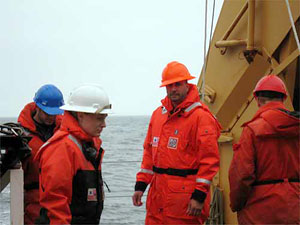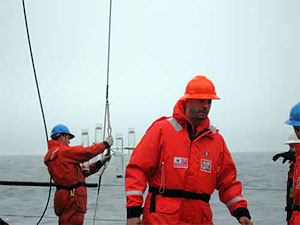

 | |||||||||||
|
|
Journals 2008/2009John Karavias
July 6, 2008 I woke up at 5:00 a.m. I am not sure if you can call it waking up if you never fell asleep. I went to bed early in anticipation of a rigorous early morning. I tossed and turned and my head kept hitting the wall as we rolled with the waves. At 6:00 a.m. I panicked and woke Pat up because I thought he overslept. He did not. Our deployment had been pushed back and he was going to let me sleep in. Oops! Woke up the P.I.! A few hours later (after a miscommunication with the science team and the crew of the Healy) we were on deck donned in Mustang Suits ready to deploy the sediment trap. Jillian Worssam, from PolarTrec, and Alex Nañez from the MATE program, took video and photos to document the deployment. Pat is very thorough and it paid dividends because there were close to 10 people involved and the drop was flawless! A big reason why the deployment went well, was with the help from the mooring team. Dave Leach and Jimmy Johnson (two old salties) really know their way around a working deck. I intend to return the favor in a few days when they are set to deploy their equipment.
After the deployment of the sediment trap was complete, Pat and I raced through lunch because the CTD was at station and we needed to get 10 bottles of water. I assisted in the retrieval of the water samples and we ran the test. Later in the day I took an engineering tour and learned about the "blood and guts" of the ship. Everything about the Healy is HUGE. The engines, generators, fresh water makers, 1.5 million gallons of fuel storage, 15,000 gallons of sewage storage, over 10,000 gallons of jet fuel storage, 30,000 gallons of oil just in one engine. The list can go on forever. Then the birders got in the action. I heard an announcement that their was a short-tailed albatross at the stern so I stopped whatever I was doing and went to the stern and saw it. It is a large black bird with an abnormally large pinkish beak. The wingspan is about 10 feet. Congratulations to Paul Suchanek, and David Porter for spotting one of possibly 2,000 known individuals of the species. I was told by Gary Friedrechsen, who is looking for right whales, the population of short-tailed albatross was nearly wiped out in the 1920's by Japanese feather hunters. The only reason why they did not go extinct is because the juveniles spent the first few years at sea. Tomorrow Pat and I have the not-so-easy task of retrieving the sediment trap. He will be in the 16-foot boat and I will be on deck. Another member of our team, Matt Tiahlo will be telling me what to do on the deck while Pat is on the Bering. Go Pat. |
||||||||||

